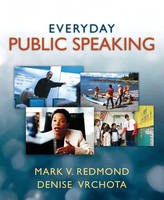
Everyday Public Speaking (book alone)
Pearson (Verlag)
978-0-205-38661-1 (ISBN)
- Titel ist leider vergriffen;
keine Neuauflage - Artikel merken
I. GETTING STARTED
1. Understanding the Fundamentals of Everyday Presentations
I. Everyday Presentations Defined
III. Presentations as Communication
A. Understanding Communication
B. Presentations as Influence
C. Presentations as Spoken Communication
IV. Four Guiding Presentational Principles
A. Understand and Adapt to the Audience and the Situation/Context
B. Think Strong to Speak Strong: Speaking Reflect Thinking
C. Balance both Style and Content: Speak with Eloquence and Sincerity
D. Maintain or Establish a Positive Relationship with the Audience.
V. An Introduction to Positive, Neutral, and Negative Audiences
A. Positive Audiences
B. Neutral Audiences
C. Negative Audiences
B. The Mixed Audience
VI. Getting to Work: The Process of Becoming a Presenter
VII. Summary
2. Planning Your First Presentation
I. Your First Presentation
II. Identify a Topic
A. Expertise
B. Experience
C. Commitment
III. Know Your Audience
A. Cultural Composition
B. Demographic Characteristics
C. Knowledge and Interests
IV. Formulate Your Speaking Goal
V. Identify Major Points
VI. Select Support Material
A. Personal Experiences
B. Other Sources
C. Supporting Major Points with the Brain in Mind
VII. Organize Your Presentation
A. From Most to Least Important Point
B. From Least to Most Important Point
C. In Chronological Order
D. In Topical Order
VIII. Create an Ear-Catching Introduction
A. Motivate Your Audience
B. Introduce Your Thesis
C. Preview Your Major Points
IX. Construct a Memorable Conclusion
A. Reinforce a Point
B. Establish Closure
X. Insert Transitions
XI. Practice and Prepare Notes
A. Achieve “Prepared Conversation” Delivery
B. Prepare Helpful Notes
C. Practice Your Presentation
XII. Manage Speech Anxiety
A. Be Yourself
B. Breathe Smart
C. Be Picky (PCCI)!
XIII. Getting to Work - Additional Tips for Speech Preparation
A. As You Prepare Your Presentation
B. On the Day of Your Presentation
C. As You Give Your Presentation
D. After Your Presentation
XIV. Chapter Summary
3. Speaking Ethically
I. Defining Ethics
II. Ethics and the First Amendment
III. The Role of Ethics in Presentations
IV. Presenting Yourself as an Ethical Speaker
A. Preserve Your Initial Credibility
B. Advocate Truthfulness
C. Consider Intentionality
V. Preparing Your Speech Using Ethical Principles
A. Present Information Clearly
B. Choose Accurate Language
C. Avoid Plagiarism
VI. Interacting With Your Audience Ethically
A. Promote Freewill
B. Eliminate Control
C. Cultivate Inclusiveness
VII. Ethical Considerations in a Diverse Environment
VIII. Ethical Considerations for Audience Members
IX. Getting to Work
X. Chapter Summary
4. Connecting with Your Audience: Delivering Your Message
I. The Importance of Delivery
A. Making Connections
B. Creating Immediacy
C. Establishing Credibility
II. The Relationship of Culture and Delivery
III. Elements of Delivery
A. Proxemics: The Way You Manage Space
1. Managing Space in the Environment
2. Managing Space with the Your Listeners
B. Kinesics: The Language of Your Body
1. Your Posture
2. Your Facial Expression
3. Your Gestures
4. Your Eye Contact
C. Physical Appearance: The Way You Look
D. Vocalics: The Sound of Your Voice
1. Fluency
2. Hesitations
3. Pitch
4. Volume
5. Clarity
6. Rate
7. Pronunciation
8. Pauses
IV. Ways to Present Your Message
A. Impromptu Presentations
B. Memorized Presentations
C. Manuscript Presentations
D. Extemporaneous Presentations
V. Getting to Work
VI. Chapter Summary
5. Listening: Being an Effective Audience Member
I. The Listening Process
A. Perceiving
B. Interpreting
C. Evaluating
D. Retaining and recalling
E. Responding
II. Reasons for Listening
III. Improving Comprehensive Listening
A. Prepare
B. Take Notes
C. Use the Difference between Thought Rate and Speech Rate
D. Maintain Attention and Minimize Noise
E. Become and Engaged, Connected, and Active Listener
III. Understanding Critical Listening
A. Improving Critical Listening
B. Major Logical Fallacies that Undermine Critical Listening
IV. Getting to Work
V. Summary
VI. Thinking Back and Thinking Ahead
II. BUILDING A PRESENTATION
6. Getting to Know Your Audience
I. Achieving Immediacy through Audience Analysis
II. Gathering Information about Your Listeners Before Your Speech
A. Observing
B. Asking
C. Surveying
D. Drawing Conclusions
III. How Listeners are Similar
A. Attract the Attention of the Audience
B. Personally Involve the Audience
C. Provide Opportunities for the Audience to Process Your Information
D. Show Your Audience the Relevance of Your Information
III. How Listeners Differ
A. Demographic Characteristics of Your Listeners
B. Motivational Characteristics
C. Listeners’ Knowledge and Interests
D. Listeners’ Attitudes, Beliefs, and Values
E. Cultural Composition
F. Relating the Differences
IV. Gathering Information From Your Listeners During and After Your Speech
V. Getting to Work
VI. Summary
7. Researching and Outlining
I. Researching the Issue
A. The Research Process and Refining the Topic
B. Synonym Topic List
C. Convergence and Divergence
D. Targeted Searches
E. Snowballing
F. Boolean Logic
II. Using the Library
A. Books
B. Journals, Magazines, and Newspapers
C. Librarians
III. The Internet as a Source of Information
IV. Interviewing
V. Outlining
A. Preparing Full-Sentence and Key-Word Outlines
B. Converting the Outline to Speaking Notes
C. Conveying the Presentational Structure to the Audience
VI. Chapter Summary
8. Supporting Your Presentation: Language and Evidence
I. Support Materials Defined
II. Consider the Audience to Determine the Type of Support Material
III. Language Forms of Support
A. Telling a Good Story
B. Figurative Language: Imagery
C. Figurative Language: Comparisons
D. Figurative Language: Illustrations and Examples
IV. Derivation Forms of Support: Reasoning and Arguments
A. Elaboration Likelihood Model
B. Reasoning
C. Arguments
V. Getting To Work
VI. Summary
VII. Thinking Back and Thinking Ahead
9. Supporting Your Presentation: Reasoning, Argument, and Strategies
I. Providing Evidence: Testimony and Statistics
A. Making Evidence Effective
B. The Use of Referenced Materials
C. The Use of Numbers and Statistics
D. Source Credibility
F. Simplify and Limit Support Material
G. Select Relevant Information
II. Using Support and Evidence Strategically
A. Use Support and Evidence to Increase Your Credibility
B. Select Evidence that is Appealing
C. Connect Support to Audience Needs
D. Appeal to the Audience’s Values and Motives
E. Show the Impact through Visualization
III. Getting To Work
IV. Summary
V. Thinking Back and Thinking Ahead
10. Supporting Your Presentation: Visual Support
I. Defining Visual Support
II. Improving Your Presentation by Using Visual Support
A. Positive Perceptions of the Presenter
B. Increased Attention
C. Improved Comprehension
D. Greater Agreement
E. Better Retention
III. Advantages to the Presenter of Incorporating Visual Support
A. Reduced Nervousness
B. Increased Clarity of Explanations
C. Reduced Dependence on Notes
D. Greater Confidence
III. Types of Visual Support
A. “Viewing” Visuals
B. “Hands On” Visuals
C. People as Visuals
IV. Design Basics for Visual Support
V. Do’s and Don’ts of Visual Support
VI. Getting to Work
VII. Summary
11. Organizing Presentations
I. Formulating Your Speech Purpose and Thesis
A. Your Speech Purpose Statement
B. Your Thesis Statement
II. Organizing Presentations for Positive Audiences
A. Organizing to Inform: Presenting to the Open Audience
B. Organizing to Inspire: Presenting to the Supportive Audience
III. Organizing Presentations for Neutral Audiences
A. Organizing To Interest: Presenting to the Apathetic Audience
B. Organizing To Interest and Inform: Presenting to the Detached Audience
C. Organizing to Influence: Presenting to the Ambivalent Audience
IV. Organizing Presentations for Negative Audiences
A. Organizing To Rekindle Interest: Presenting to the Passive Audience
B. Organizing To Redirect Interest: Presenting to the Active Audience
V. Getting to Work
VI. Chapter Summary
12. Managing the Organization: Introductions, Conclusions, and Transitions
I. Introductions
A. Why Does Your Presentation Need an Introduction?
B. Components of the Introduction
C. Developing Introductions for Positive, Negative, and Neutral Audiences
II. Conclusions
A. Why Does Your Presentation Need a Conclusion?
B. Components of the Conclusion
C. Developing Conclusions for Positive, Negative, and Neutral Audiences
III. Transitions
A. Why Does Your Presentation Need Transitions?
B. Types of Transitions
C. Developing Transitions for Positive, Negative, and Neutral Audiences
IV. Getting to Work
V. Summary
13. Responding to Audiences
I. Guidelines for Responding to Questions
II. Responding During the Presentation
A. Taking Points Out of Order
B. Discussing Unintended Issues
C. Losing Listeners’ Attention
D. Operating Within a Timeframe
III. Responding After the Presentation
A. When You Know the Answer
B. When You Don’t Know the Answer
C. When No One Asks
IV. Responding to Challenges
A. Challenging Questions
B. Challenging Questioners
V. Getting to Work
VI. Chapter Summary
III. PRESENTING TO SPECIFIC AUDIENCES
14. Making Presentations to Positive Audiences: To Inspire and Inform
I. Positive Audiences: Supportive and Open
II. Goal Setting for Positive Audiences
III. Identifying Supportive and Open Audiences
IV. Strategies for Presenting to Positive Audiences
A. Speaking to Inspire and Enhance Interest: Speaking to Supportive Audiences
B. Speaking to Inform: Speaking to Open Audiences
C. Speaking to Evoke a Positive Attitude
V. Getting to Work
15. Making Presentations to Neutral Audiences: To Interest and Inform
I. Neutral Audiences: Apathetic, Detached, and Ambivalent.
II. Goal Setting for Neutral Audiences
III. Identifying Apathetic, Detached, and Ambivalent Audiences
IV. Strategies for Dealing with Neutral Audiences
A. Addressing the Lack of Interest (Detached and Apathetic Audiences)
B. Adapting to the Lack of Knowledge (Detached Audiences)
C. Addressing the Knowledgeable Neutral Audiences: Apathetic and Ambivalent
V. Getting To Work
VI. Chapter Summary
16. Making Presentations to Negative Audiences: To Placate and Persuade
I. Negative Audiences: Passive and Active
A. Reasons Negative Audiences Attend Presentations
B. Moving the Audience Along the Continuum of Resistance
II. Goal Setting for Negative Audiences
III. Strategies for Addressing Negative Audiences
A. Foothold Strategies
B. Psychological Strategies
C. Support Strategies
D. Organizational Strategies
IV. Getting to Work
V. Chapter Summary
VI. Thinking Back and Thinking Ahead
17. Making Presentations on Special Occasions: To Recognize and Remember
I. Principles of Special Occasion Speeches (Epideictic Rhetoric)
A. Principle 1: Demonstrate Praise or Blame
B. Principle 2: Amplification
C. Principle 3: Celebrating the Present
D. Principle 4: Role of the Audience
E. Principle 5: Ceremony
II. Special Occasions
A. Speeches of Welcome and Introduction
B. Speaking to Honor and to Remember
C. Speeches of Farewell
D. Toasts
E. Award Ceremonies
F. Nominations
G. Dinner Speeches
III. Getting to Work
IV. Summary
APPENDIXES
Appendix A: Working with Colleagues to Organize a Team Presentation
I. The Nature of Teams and Groups
A. Issues of Structure
B. Issues of Climate
C. Issues of Product
D. Issues of Process
II. Why Give a Team Presentation?
III. A Problem Solving Approach to Constructing Team Presentations
IV. Preparing a Team Presentation
IV. Other Formats for Team Presentations
A. The Panel Discussion
B. The Symposium
C. The Forum
D. The Colloquy
V. General Tips for Constructing and Presenting Team Presentations
VII. Getting to Work
VIII. Chapter Summary
Appendix B: Working with PowerPoint
Appendix C: The Classical Tradition to Rhetoric
Appendix D: Sample Speeches
| Erscheint lt. Verlag | 25.10.2006 |
|---|---|
| Sprache | englisch |
| Maße | 191 x 232 mm |
| Gewicht | 818 g |
| Themenwelt | Sachbuch/Ratgeber ► Beruf / Finanzen / Recht / Wirtschaft ► Briefe / Präsentation / Rhetorik |
| ISBN-10 | 0-205-38661-X / 020538661X |
| ISBN-13 | 978-0-205-38661-1 / 9780205386611 |
| Zustand | Neuware |
| Haben Sie eine Frage zum Produkt? |
aus dem Bereich



